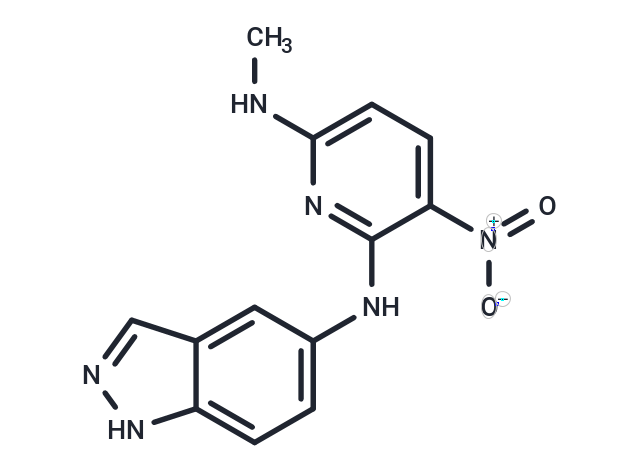Shopping Cart
Remove All Your shopping cart is currently empty
Your shopping cart is currently empty
KRIBB11 is an inhibitor of Heat Shock Factor (HSF) [inhibitor].

| Pack Size | Price | USA Warehouse | Global Warehouse | Quantity |
|---|---|---|---|---|
| 5 mg | $47 | In Stock | In Stock | |
| 10 mg | $70 | In Stock | In Stock | |
| 25 mg | $162 | In Stock | In Stock | |
| 50 mg | $276 | In Stock | In Stock | |
| 100 mg | $537 | In Stock | In Stock | |
| 200 mg | $755 | In Stock | In Stock | |
| 500 mg | $1,150 | - | In Stock | |
| 1 mL x 10 mM (in DMSO) | $48 | In Stock | In Stock |
| Description | KRIBB11 is an inhibitor of Heat Shock Factor (HSF) [inhibitor]. |
| Targets&IC50 | HSF1:1.2 μM |
| In vitro | KRIBB11 inhibits HSF1 activity in a concentration-dependent manner. It down-regulates HSP70 and HSP27. KRIBB11 can inhibit cancer cell proliferation, arrests the cell cycle at G2/M phase and induces apoptosis. But it does not inhibit heat shock-induced recruitment of HSF1 to the hsp70 promoter or phosphorylation of HSF1 Ser-230. KRIBB11 inhibits heat shock-induced recruitment of pTEFb to the hsp70 promoter and p-TEFb-dependent Phosphorylation of polⅡ CTD Ser-2[1]. |
| In vivo | Using a mouse xenograft model, KRIBB11 treatment decreases tumor volume by 47% compared with untreated control mice. In addition, HSP70 protein levels are significantly decreased in tumors from mice treated with KRIBB11, supporting the notion that KRIBB11 exerts its in vivo antitumor activity through HSF1 inhibition[1]. |
| Kinase Assay | HCT-116 cells are washed with PBS and then homogenized with a 27-gauge syringe in binding buffer (10 mm Tris-HCl (pH 7.4), 50 mm KCl, 5 mm MgCl2, 1 mm EDTA, and 0.1 mm Na3VO4). The cell lysate is centrifuged at 13,000 rpm for 30 min at 4°C, and the supernatant is collected. The HCT-116 cell lysate supernatant is precleared by incubating with Dynabeads M-280 streptavidin for 30 min at 4°C and captured by magnet separation. The cleared supernatants are incubated with biotinyl-KRIBB11 compound. After overnight incubation at 4°C, proteins associated with the biotinyl-KRIBB11 compound are precipitated with Dynabeads M-280 streptavidin. Precipitated samples are separated by a magnet. Samples are washed with 1 mL of ishing buffer containing 50 mm HEPES (pH 7.5), 50 mm NaCl, 1 mm EDTA, 1 mm EGTA, 0.1% Tween 20, 10% (v/v) glycerol, 1 mm NaF, 0.1 mm Na3VO4, and protease inhibitor mixture tablets (1 tablet/10 mL). Samples are boiled in SDS-PAGE sample buffer, separated by 10% polyacrylamide gel, and immunoblotted with antibodies against HSF1, HSF2, HSP90, or CDK9. |
| Cell Research | HCT-116 cells are treated with KRIBB11 at various concentrations for 48 h. Cells are then harvested by trypsinization, fixed with 70% chilled ethanol, and preserved at ?20 °C before FACS analysis. Fixed cells are washed twice with phosphate-buffered saline (PBS) solution before being suspended in 500 μl of PBS and treated with 100 mg/ml RNase A at 37 °C for 30 min. Propidium iodide is then added to a final concentration of 50 mg/ml for DNA staining, and 20,000 fixed cells are analyzed on a FACSCalibur system. Cell cycle distribution is analyzed using the ModFit program.(Only for Reference) |
| Molecular Weight | 284.27 |
| Formula | C13H12N6O2 |
| Cas No. | 342639-96-7 |
| Smiles | CNc1ccc(c(Nc2ccc3[nH]ncc3c2)n1)[N+]([O-])=O |
| Relative Density. | 1.531 g/cm3 (Predicted) |
| Storage | Powder: -20°C for 3 years | In solvent: -80°C for 1 year | Shipping with blue ice/Shipping at ambient temperature. | ||||||||||||||||||||
| Solubility Information | Ethanol: < 1 mg/mL (insoluble or slightly soluble) DMSO: 3 mg/mL (10.55 mM), Sonication is recommended. H2O: < 1 mg/mL (insoluble or slightly soluble) | ||||||||||||||||||||
| In Vivo Formulation | 10% DMSO+40% PEG300+5% Tween 80+45% Saline: 1 mg/mL (3.52 mM), Sonication is recommended. Please add the solvents sequentially, clarifying the solution as much as possible before adding the next one. Dissolve by heating and/or sonication if necessary. Working solution is recommended to be prepared and used immediately. The formulation provided above is for reference purposes only. In vivo formulations may vary and should be modified based on specific experimental conditions. | ||||||||||||||||||||
Solution Preparation Table | |||||||||||||||||||||
DMSO
| |||||||||||||||||||||
| Size | Quantity | Unit Price | Amount | Operation |
|---|

Copyright © 2015-2025 TargetMol Chemicals Inc. All Rights Reserved.